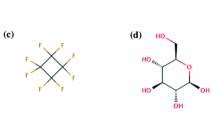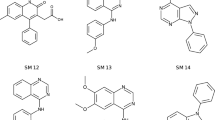Abstract
Hydration free energy calculations are often used to validate molecular simulation methodologies and molecular mechanics force fields. We use the free-energy perturbation method together with the AMOEBA polarizable force field and the Poltype parametrization protocol to predict the hydration free energies of 52 molecules as part of the SAMPL4 blind challenge. For comparison, similar calculations are performed using the non-polarizable General Amber force field. Against our expectations, the latter force field gives the better results compared to experiment. One possible explanation is the sensitivity of the AMOEBA results to the conformation used for parametrization.








Similar content being viewed by others
References
Mobley DL, Dill KA, Chodera JD (2008) Treating entropy and conformational changes in implicit solvent simulations of small molecules. J Phys Chem B 112:938–946
Mobley DL, Bayly CI, Cooper MD, Shirts MR, Dill KA (2009) Small molecule hydration free energies in explicit solvent: an extensive test of fixed-charge atomistic simulations. J Chem Theory Comput 5(2):350–358
Sulea T, Corbeil CR, Purisima EO (2010) Rapid prediction of solvation free energy. 1. An extensive test of linear interaction energy (LIE). J Chem Theory Comput 6(5):1608–1621
Oostenbrink C, Villa A, Mark AE, van Gunsteren WF (2004) A biomolecular force field based on the free enthalpy of hydration and solvation: the gromos force field parameter sets 53A5 and 53A6. J Comput Chem 25(13):1656–1676
Cieplak P, Dupradeau FY, Duan Y, Wang JM (2009) Polarization effects in molecular mechanical force fields. J Phys Condens Matter 21(33):333102
Ponder JW, Wu C, Ren P, Pande VS, Chodera JD, Schnieders MJ, Haque I, Mobley DL, Lambrecht DS, DiStasio RA Jr (2010) Current status of the AMOEBA polarizable force field. J Phys Chem B 114(8):2549–2564
Wu JC, Chattree G, Ren PY (2012) Automation of AMOEBA polarizable force field parameterization for small molecules. Theor Chem Acc 131(3):1138
Huang L, Roux B (2013) Automated force field parameterization for non-polarizable and polarizable atomic models based on target data. J Chem Theory Comput 9(8):3543–3556
Shi Y, Wu CJ, Ponder JW, Ren PY (2011) Multipole electrostatics in hydration free energy calculations. J Comput Chem 32(5):967–977
Wang J, Wolf RM, Caldwell JW, Kollman PA, Case DA (2004) Development and testing of a general AMBER force field. J Comput Chem 25(9):1157–1174
O’Boyle NM, Banck M, James CA, Morley C, Vandermeersch T, Hutchison GR (2011) Open babel: an open chemical toolbox. J Cheminform 3:33
Becke AD (1993) J Chem Phys 98:1372
Hariharan PC, Pople JA (1973) Theor Chem Acc 28:213
Tomasi J, Mennucci B, Cammi R (2005) Quantum mechanical continuum solvation models. Chem Rev 105(8):2999–3093
Frisch MJ, Trucks GW, Schlegel HB, Scuseria GE, Robb MA, Cheeseman JR, Scalmani G, Barone V, Mennucci B, Petersson GA, Nakatsuji H, Caricato M, Li X, Hratchian HP, Izmaylov AF, Bloino J, Zheng G, Sonnenberg JL, Hada M, Ehara M, Toyota K, Fukuda R, Hasegawa J, Ishida M, Nakajima T, Honda Y, Kitao O, Nakai H, Vreven T, Montgomery Jr JA, Peralta JE, Ogliaro F, Bearpark M, Heyd JJ, Brothers E, Kudin KN, Staroverov VN, Kobayashi R, Normand J, Raghavachari K, Rendell A, Burant JC, Iyengar SS, Tomasi J, Cossi M, Rega N, Millam JM, Klene M, Knox JE, Cross JB, Bakken V, Adamo C, Jaramillo J, Gomperts R, Stratmann RE, Yazyev O, Austin AJ, Cammi R, Pomelli C, Ochterski JW, Martin RL, Morokuma K, Zakrzewski VG, Voth GA, Salvador P, Dannenberg JJ, Dapprich S, Daniels AD, Farkas Ö, Foresman JB, Ortiz JV, Cioslowski J, Fox DJ (2009) Gaussian 09 Revision A.1. Gaussian Inc. Wallingford
Ren P, Ponder JW (2003) Polarizable atomic multipole water model for molecular mechanics simulation. J Phys Chem B 107:5933
Stone AJ, Alderton M (2005) Distributed multipole analysis: stability for large basis sets. J Chem Theory Comput 1:1128
Stone AJ, Alderton M (1985) Distributed multipole analysis—methods and applications. Mol Phys 56:1047
Zhao Y, Truhlar DG (2006) A new local density functional for main-group thermochemistry, transition metal bonding, thermochemical kinetics, and noncovalent interactions. J Chem Phys 125:194101
Jorgensen WL, Chandrasekhar J, Madura JD, Impey RW, Klein ML (1983) J Chem Phys 79:926
Case D, Darden T, TE Cheatham I, Simmerling C, Wang J, Duke R, Luo R, Walker R, Zhang W, Merz K, Roberts B, Hayik S, Roitberg A, Seabra G, Swails J, Goetz A, Kolossvary I, Wong K, Paesani F, Vanicek J, Wolf R, Liu J, Wu X, Brozell S, Steinbrecher T, Gohlke H, Cai Q, Ye X, Wang J, Hsieh MJ, Cui G, Roe D, Mathews D, Seetin M, Salomon-Ferrer R, Sagui C, Babin V, Luchko T, Gusarov S, Kovalenko A, Kollman P (2012) Amber 12. University of California, San Francisco
Jakalian A, Bush BL, Jack DB, Bayly CI (2000) Fast, efficient generation of high-quality atomic charges. AM1-BCC model: I. Method. J Comput Chem 21(2):132–146
Mobley DL, Dumont É, Chodera JD, Dill KA (2007) Comparison of charge models for fixed-charge force fields: small-molecule hydration free energies in explicit solvent. J Phys Chem B 111(9):2242–2254
Hess B, Kutzner C, van der Spoel D, Lindahl E (2008) Gromacs 4: algorithms for highly efficient, load-balanced, and scalable molecular simulation. J Chem Theory Comput 4(3):435–447
Ryckaert JP, Ciccotti G, Berendsen HJC (2008) J Comput Phys 23:327
Shirts MR, Chodera JD (2008) Statistically optimal analysis of samples from multiple equilibrium states. J Chem Phys 129:124105
Mobley DL, Wymer K, Lim NM (2014) Blind prediction of solvation free energies from the SAMPL4 challenge. doi:10.1007/s10822-014-9718-2
Reynolds CA, Essex JW, Richards WG (1992) Atomic charges for variable molecular conformations. J Am Chem Soc 114:9075
Stouch TR, Williams DE (1992) Conformational dependence of electrostatic potential derived charges of a lipid headgroup: glycerylphosphorylcholine. J Comput Chem 13:622–632
Stouch TR, Williams DE (1993) Conformational dependence of electrostatic potential-derived charges: studies of the fitting procedure. J Comput Chem 14:858–866
Bayly CI, Cieplak P, Cornell WD, Kollman PA (1993) A well-behaved electrostatic potential based method using charge restraints for deriving atomic charges: the RESP model. J Phys Chem 97:10269
Söderhjelm P, Ryde U (2009) Conformational dependence of charges in protein simulations. J Comput Chem 30:750
Acknowledgments
This investigation has been supported by a grant from the Swedish research council (agreement C0020401). The computations were performed on computer resources provided by the Swedish National Infrastructure for Computing (SNIC) at Lunarc at Lund University and HPC2N at Umeå University.
Author information
Authors and Affiliations
Corresponding author
Rights and permissions
About this article
Cite this article
Manzoni, F., Söderhjelm, P. Prediction of hydration free energies for the SAMPL4 data set with the AMOEBA polarizable force field. J Comput Aided Mol Des 28, 235–244 (2014). https://doi.org/10.1007/s10822-014-9733-3
Received:
Accepted:
Published:
Issue Date:
DOI: https://doi.org/10.1007/s10822-014-9733-3




